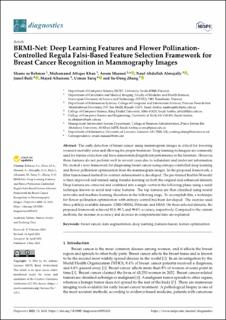| dc.contributor.author | Rehman, Shams ur | |
| dc.contributor.author | Khan, Muhamamd Attique | |
| dc.contributor.author | Masood, Anum | |
| dc.contributor.author | Almujally, Nouf Abdullah | |
| dc.contributor.author | Baili, Jamel | |
| dc.contributor.author | Alhaisoni, Majed | |
| dc.contributor.author | Tariq, Usman | |
| dc.contributor.author | Zhang, Yu-Dong | |
| dc.date.accessioned | 2023-11-29T07:34:48Z | |
| dc.date.available | 2023-11-29T07:34:48Z | |
| dc.date.created | 2023-05-30T12:17:48Z | |
| dc.date.issued | 2023 | |
| dc.identifier.citation | Diagnostics (Basel). 2023, 13 (9), . | en_US |
| dc.identifier.issn | 2075-4418 | |
| dc.identifier.uri | https://hdl.handle.net/11250/3105125 | |
| dc.description.abstract | The early detection of breast cancer using mammogram images is critical for lowering women’s mortality rates and allowing for proper treatment. Deep learning techniques are commonly used for feature extraction and have demonstrated significant performance in the literature. However, these features do not perform well in several cases due to redundant and irrelevant information. We created a new framework for diagnosing breast cancer using entropy-controlled deep learning and flower pollination optimization from the mammogram images. In the proposed framework, a filter fusion-based method for contrast enhancement is developed. The pre-trained ResNet-50 model is then improved and trained using transfer learning on both the original and enhanced datasets. Deep features are extracted and combined into a single vector in the following phase using a serial technique known as serial mid-value features. The top features are then classified using neural networks and machine learning classifiers in the following stage. To accomplish this, a technique for flower pollination optimization with entropy control has been developed. The exercise used three publicly available datasets: CBIS-DDSM, INbreast, and MIAS. On these selected datasets, the proposed framework achieved 93.8, 99.5, and 99.8% accuracy, respectively. Compared to the current methods, the increase in accuracy and decrease in computational time are explained. | en_US |
| dc.language.iso | eng | en_US |
| dc.publisher | MDPI | en_US |
| dc.rights | Navngivelse 4.0 Internasjonal | * |
| dc.rights.uri | http://creativecommons.org/licenses/by/4.0/deed.no | * |
| dc.subject | breast cancer | en_US |
| dc.subject | data augmentation | en_US |
| dc.subject | deep learning | en_US |
| dc.subject | features fusion | en_US |
| dc.subject | feature optimization | en_US |
| dc.title | BRMI-Net: Deep Learning Features and Flower Pollination-Controlled Regula Falsi-Based Feature Selection Framework for Breast Cancer Recognition in Mammography Images | en_US |
| dc.title.alternative | BRMI-Net: Deep Learning Features and Flower Pollination-Controlled Regula Falsi-Based Feature Selection Framework for Breast Cancer Recognition in Mammography Images | en_US |
| dc.type | Journal article | en_US |
| dc.type | Peer reviewed | en_US |
| dc.description.version | publishedVersion | en_US |
| dc.source.volume | 13 | en_US |
| dc.source.journal | Diagnostics (Basel) | en_US |
| dc.source.issue | 9 | en_US |
| dc.identifier.doi | 10.3390/diagnostics13091618 | |
| dc.identifier.cristin | 2150141 | |
| cristin.ispublished | true | |
| cristin.fulltext | original | |
| cristin.qualitycode | 1 | |

